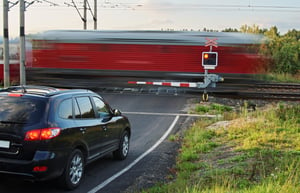 Getting stuck at a railroad crossing with a super-long freight train can test anyone’s patience. In some cases, this delay will cause you to be late to your appointment, as it may take 10 minutes for the train to clear.
Getting stuck at a railroad crossing with a super-long freight train can test anyone’s patience. In some cases, this delay will cause you to be late to your appointment, as it may take 10 minutes for the train to clear.
When jumbo frames on a VoIP/UC network are enabled, it can cause the same kind of delay to your network transmissions.
What Are Jumbo Frames?
A normal Ethernet maximum payload size is 1500 bytes of information. The Ethernet header is 18 bytes, so this creates a total Ethernet frame size of 1518 (or 1522 with a VLAN tag). That is just one example of "extras" — Ethernet supports up to 482 bytes of these added fields for a maximum frame size of 2000 bytes. The data payload of 1500 bytes is a universally accepted size that every network device can handle, yet payloads are not optimized for any particular application.
VoIP/UC applications transmit payloads that are small, typically under 200 bytes, so they don’t use the entire 1500 bytes possible.
Jumbo frames are not standardized, but can typically be configured on network switches and routers to support a maximum payload of 9000 bytes (9018 with header, or 9022 with header and VLAN tag).
Where Can You Use Jumbo Frames?
Jumbo frames can only be used on links that are gigabit or faster, on switches, routers, and servers that can be configured to support jumbo frames. 10-megabit and 100-megabit Ethernet does not support jumbo frames.
Where Should You Use Jumbo Frames?
The best places to use jumbo frames are:
- Virtual switches: Moving 9000-byte frames around inside RAM is easy to do and won’t cause problems. The performance boost is appreciated by all applications due to the lower overhead.
- iSCSI and NAS boxes: On the back-end of a server infrastructure, it allows more data to move quicker into the servers as well as backup devices.
Where Should You Not Use Jumbo Frames?
The worst places to use jumbo frames are:
- WAN links: Loss across WAN links will be more painful, as the retransmit latency will be typically very high. Additionally, WAN links usually have less available bandwidth. That lowers QoS effectiveness, because VoIP/UC packets cannot be inserted in the middle of a jumbo frame that is currently being transmitted. This increases latency and jitter for the VoIP/UC call.
- WiFI: Wireless links usually have a certain amount of loss. This loss will cause a lot of lost bandwidth due to an entire 9000-byte frame being discarded (whereas losing a single 1500-byte frame is not as painful). Plus, if a few stations are sending huge packets then they unfairly consume the limited available wireless bandwidth.
Why Are Jumbo Frames Awesome?
If you have a lot of multi-gigabyte files to transfer, larger payloads allow more data to be transferred with less overhead. You may encounter a 10-20% performance improvement due to the reduced overhead.
Why Are Jumbo Frames Terrible?
Real-time protocols like VoIP, UC, and video need a steady stream of smaller packets. If they are stuck behind a freight-train of jumbo frames, then users may hear choppy voice and see video dropouts.
How Do You Solve Latency and Jitter Caused by Jumbo Frames?
Latency and jitter problems can be mitigated by adding QoS at layer 2 and layer 3 in the portion of the network configured for jumbo frames, or isolating the VoIP/UC/Video traffic to an alternate path through the network with policy routing.
Links that are 10 gigabit and faster have less problems handling both large and small packets, due to the serialization delay being reduced by the factor of ten. This lessens the problem with VoIP/UC/Video.
VoIP call quality problems can be prevented if the right information is brought to bear about your network’s performance.
Review our white paper or contact us with questions about how PathSolutions can solve call quality and many other VoIP issues.
See also: Run for Your Lives, Attack of the Giant Ethernet Frames






